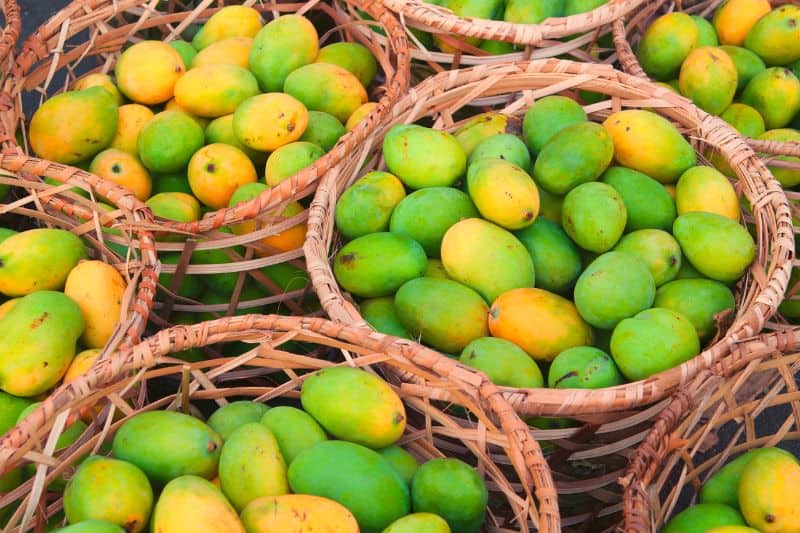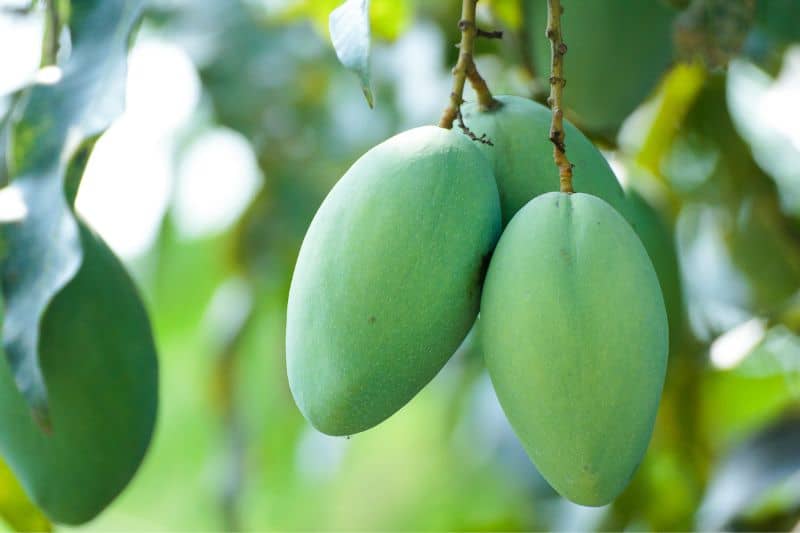Mangoes, a delicious tropical fruit, have been enjoyed by people worldwide for centuries. The sweet and juicy taste and impressive nutritional profile have earned them the nickname “the king of fruits.” One question that might come to mind when we think about mangoes is their weight – how much does a mango weigh?
In this article, we’ll explore the factors that contribute to a mango’s weight and provide an overview of the average weights of some commonly consumed mango varieties. This knowledge will come in handy next time you find yourself in the produce aisle, trying to pick the perfect mango!
Read: How Much Does a 12-Pack of Soda Weigh?
There are many varieties of mangoes, each with its own unique flavor, texture, and size. This makes it quite challenging to give a specific weight for all mangoes, as they can vary significantly. Typically, mangoes can weigh anywhere from 200 grams to over one kilogram, with the average mango weighing about 300-500 grams.
Factors Influencing Mango Weight
Size and Variety
Several factors influence the weight of a mango, and one of the most important factors is the size and variety of the mango. There are over 500 different types of mangoes, ranging from small to large, each with its distinct taste, shape, and weight.
For example, Alphonso and Kent mangoes generally weigh between 300 and 500 grams, while smaller varieties like Ataulfo weigh around 150 to 300 grams.
Stage of Maturity
Another factor that affects the weight of a mango is its stage of maturity. As a mango ripens, its weight will change depending on the variety and growing conditions. When a mango is still green (unripe), it is relatively lighter due to the lower sugar and water content.
As the mango ripens, it gains weight, thanks to increased sugar and water content within the fruit. Therefore, a fully ripe mango will weigh more than an unripe one in most cases.
Geographic Location
The geographic location in which a mango is cultivated has a significant impact on its weight as well. Factors such as climate, elevation, and soil composition all play a role in determining the weight of the mango.
For example, mangoes grown in a tropical climate with abundant rainfall may be heavier than those grown in drier regions, as these conditions are more conducive to the growth and development of the fruit.

Average Weight of a Mango
I just love mangoes, and if you’re like me, you might be curious about how much an average mango weighs. There’s something satisfying about knowing the details of our favorite fruits.
When it comes to mangoes, there’s quite a variety available in terms of size, shape, and weight. However, generally speaking, an average mango weighs between 200 and 300 grams (7 to 10 ounces). But, let me break it down a bit further while keeping it friendly and brief.
- Small-sized mangoes: These cute little mangoes usually weigh around 150 to 200 grams (5 to 7 ounces), and you can often find them in the Ataulfo or Alphonso varieties. They still pack a flavorful punch, despite their size.
- Medium-sized mangoes: This is where most mangoes reside, and they typically weigh between 200 and 350 grams (7 to 12 ounces). Examples include Haden and Tommy Atkins varieties. They are common in your local supermarket and offer a good balance of weight and taste.
- Large-sized mangoes: We’re talking about the big guys here – Keitt and Kent varieties, for example. These hefty fruits weigh anywhere between 350 and 500 grams (12 to 17 ounces) or even more. This size will surely make you smile if you’re a true mango lover.
Remember that these weight ranges are approximate and can vary depending on various factors, such as the specific variety, growing conditions, and ripeness.

How is Mango Weight Measured?
I love mangoes, and if you’re like me, you might be curious about how much these juicy fruits weigh. The weight of a mango actually varies depending on its size, variety, and ripeness. I’ll explain how mango weight is measured in a friendly way.
First, let me tell you that mangoes are usually categorized into three main sizes: small, medium, and large. To measure the weight of a mango, we can use a simple kitchen scale. Just place the mango on the scale and note the weight in grams or ounces.
Different varieties of mangoes have different average weights. For example, the Ataulfo mango – often called a champagne mango – is a small to medium-sized mango and typically weighs between 5 and 12 ounces. On the other hand, larger mango varieties like the Tommy Atkins or Haden can weigh anywhere between 12 and 24 ounces.
It’s important to note that the stage of ripeness can also affect the weight of a mango. As the fruit ripens, it loses some water content, ultimately making it slightly lighter. So, don’t be surprised if a ripe mango weighs a bit less than its unripe counterpart.
Various Mango Varieties and Their Weights
As a mango lover, I know that there are countless varieties of mangoes out there, each type varying in weight based on factors such as size, shape, and ripeness. Let me share a table with some popular mango varieties and their average weights:
| Mango Variety | Average weight (grams) |
|---|---|
| Alphonso | 200-300 |
| Ataulfo | 150-300 |
| Haden | 300-500 |
| Keitt | 500-700 |
| Kent | 400-600 |
| Tommy Atkins | 400-600 |
The Alphonso mango, often called the “King of Mangoes,” is a delightful treat that weighs on average between 200-300 grams. Known for their sweet, rich taste and bright orange pulp, Alphonso mangoes are popular among mango enthusiasts worldwide.
Another delicious variety is the Ataulfo mango, which weighs 150-300 grams. These mangoes have a creamy texture and a distinct curved shape, with a slightly smaller size than other varieties.
The Haden mango, a favorite in many parts of the United States, weighs 300-500 grams. With beautifully blushed skin, juicy pulp, and a fragrant aroma, the Haden is hard to resist.
Keitt mangoes, weighing around 500-700 grams, are among the heaviest mango varieties. They have less fibrous texture and are an excellent choice for smoothies, juice, or eating fresh right off the tree.
Next up, Kent mangoes typically weigh between 400-600 grams and boast an oval shape with a deep green skin. Beneath the tough exterior, you’ll find a sweet, fibrous, and delectable pulp that makes a fantastic snack.
Finally, the Tommy Atkins mango, a common sight in supermarkets, typically weighs 400-600 grams. Their firm flesh stays intact even when ripe, making them perfect for various culinary uses.
How Much Does a Mango Pit Weigh?
I’ve always been a mango enthusiast, and I’m quite curious about the weight of their pits. After some research, I found out that the weight of a mango pit can vary depending on factors like mango size and variety. Let’s explore this in more detail:
Typically, the weight of a mango pit ranges from 50 to 100 grams or 1.7 to 3.5 ounces.
When it comes to mango varieties, there are a few that differ in pit weights. Some common mango varieties and their approximate pit weights are:
- Tommy Atkins: 60-80 grams (2.1-2.8 ounces)
- Haden: 50-70 grams (1.7-2.4 ounces)
- Alphonso: 45-60 grams (1.5-2.1 ounces)
- Kent: 75-100 grams (2.6-3.5 ounces)
Now, let’s put this into perspective. In general, a whole mango weighs around 300-500 grams (10-17 ounces). This means the mango pit can contribute to roughly 12-25% of the mango’s total weight.
While analyzing mango weights, keep in mind that these numbers are approximate. The actual weight might slightly vary due to factors like ripeness and individual mango sizes. But now, whenever you enjoy your favorite mango, you have an idea about the weight of the pit that you’ll be discarding!
Read: How Much Does a Pint of Cherry Tomatoes Weigh?
Methods of Measuring Mango Weight
When I want to measure the weight of a mango, there are a variety of methods I can use. In this section, I will share a few of those methods that I find to be the most accurate and convenient for measuring mango weight.
1. Using a kitchen scale: This is my go-to method, as I find it to be the most precise way to measure the weight of a mango. I simply place the mango on the kitchen scale, and it gives me the weight in grams or ounces. It is important to make sure that the scale is tared (zeroed out) before placing the mango on it to ensure accuracy.
2. Using a produce scale at the grocery store: If I happen to be at the grocery store, I can also use the produce scale available in the fruit section. These scales are designed for customers to weigh their own produce, so they are user-friendly. Again, I make sure to place an empty container or plastic bag on the scale before adding the mango to account for the tare weight.
3. Estimating based on size and general weight: If I don’t have a scale readily available, I can still estimate the weight of a mango by comparing it to the average weight of common mango varieties. Here are some average weights for different mango types:
- Ataulfo (Honey) mango: 250-400 grams
- Haden mango: 400-600 grams
- Tommy Atkins mango: 500-800 grams
- Kent mango: 600-900 grams
By familiarizing myself with these average weights and closely examining the size of the mango, I can make an educated guess about its weight.







